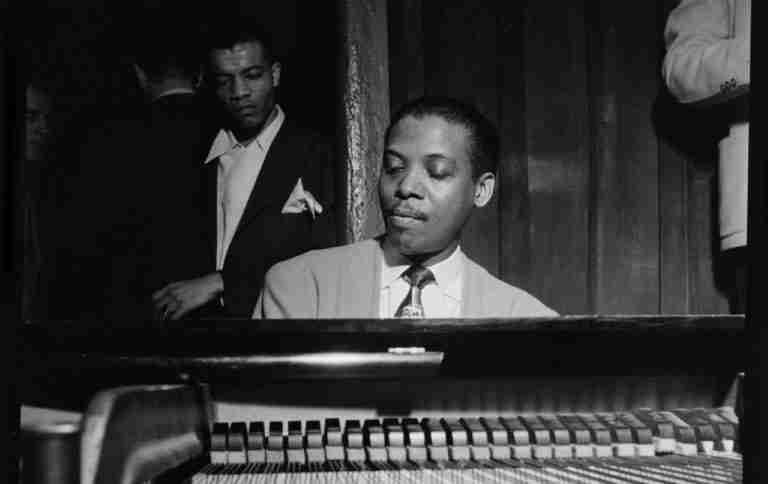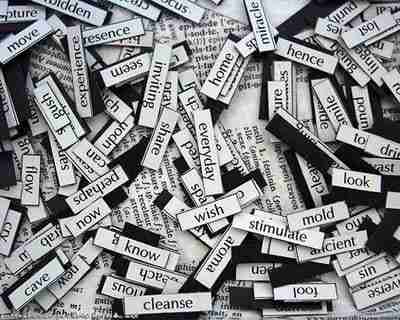A recurring theme on this site seems to be language – acquiring, practicing, and applying the jazz language. There is a reason behind all the repetition, however. Language is a very powerful concept when it comes to improvisation and it’s an idea that can drastically change your mentality about the music.
But, even before you get to the idea of acquiring, applying, and transforming pieces of language, there is a much more basic issue at hand here: Why should you even learn language in the first place?
When you get down to it, no one is requiring you to learn lines from the records or to imitate the style of a famous musician. There is no mandatory rule that you have to improvise in a certain way and you can easily create solos with the “right notes” using memorized scales. So why bother spending that extra time to learn someone else’s solos and language?
It all boils down to musicality. What is it that defines the musicality in your playing? Where do you learn musicality without imitation or listening? Musicality is the reason you play music in the first place. Without emotion, style, and shape those chords and scales would be, well, just chords and scales.
If I had to name the one thing that improved my playing more than anything else, the thing that made me finally “get it” when it came to improvising, it would have to be language. Before I began to transcribe solos and study the language of the music, I had my theory down cold. I had all my scales memorized, could play them in thirds and fourths, and could even play arpeggios in all inversions.
However, when it came to improvising interesting ideas and melodies, connecting chord progressions, and playing long, flowing lines in my solos, I hit a brick wall. I knew my scales well, but I couldn’t seem to turn that theoretical knowledge into the creative lines and phrases that I was hearing on my favorite records.
“We dissect nature along lines laid down by our native language. Language is not simply a reporting device but a defining framework for it.”~Benjamin Lee Whorf
Think about the players you’ve heard at jam sessions and concerts. What’s the main difference between a beginner and someone that sounds good soloing over chord progressions? It comes down to language. You can immediately hear the difference between the player that is listening to records and transcribing solos and the player that is struggling to create lines with memorized scales. The contrast is like night and day.
The majority of struggling musicians that can’t seem to improve approach improvisation the same way, fitting scales into chord progressions. This is where I was stuck for years. It just wasn’t working. While scales do have their place in the learning process, they are not the end result, they are merely the beginning, a doorway to learning language off the records.
An important change occurs as you master the technique of scales, and more importantly the sound of chords, and move on to learning and hearing language over these progressions. As you study lines and phrases you begin to see how to put those scales and arpeggios to use. Now you’re starting to develop a sense of musicality.
By looking at music and the jazz tradition of improvisation as a language, your perception of the process of improvisation becomes completely altered. The prospect of creating a solo becomes filled with possibilities, where as before you were stuck in the flat-view of the world: plugging scales into chord progressions.
Coming to this realization is a major breakthrough in the process of learning to improvise and a stepping stone to maturing musically as an improviser.
The music of language
What comes to mind when you think of the word language?
I’m willing to bet that you think of the actual sound of the spoken words before you think of technical things like sentence structure or verb conjugation. The accents, the style, the rhythm, the mouth feeling of speaking, even the cultural associations that are connected with the spoken words. These are the aspects that define the language to a speaker and the people listening to it.
Think about French, Spanish, German, Mandarin…the sound of the language comes immediately to mind and the feeling of the place along with it. Language has an intrinsic connection to the culture and style of it’s speakers. Even between regional dialects and accents (think New York vs. the Midwest) there is an apparent variation that reflects attitude and a mentality about life.
More than just words grouped together to impart meaning, language has style and an inherent musicality.
In every language we all basically say the same things from sun up to sun down, but it’s the pronunciation, the personality, the accents, and tradition that sets everything apart. Our language and our way of speaking gives us an identity and adds another layer of complexity to our communication with the outside world.
There is much more to what you say than the actual content of the words you use. Language is composed of words that have meaning, but we say much more when we speak. Your posture, your facial expression, the inflection of your words. People listen to your intent and the way you say things more than the actual content of your sentences.
Words, ideas, and the flow of communication
Imagine for a second that you’re stranded while traveling in a foreign country and not speaking the language, all you have are 8 key words in your trusty phrase book. You’ve lost your luggage and are desperately trying to find out if anyone has seen it.
It is clear that the other people can understand these individual words and the words are relevant to your subject, but is it possible to make a phrase that even makes sense, let alone something that conveys your message or what you’re thinking?
Without a knowledge of the language or experience in creating phrases, you’ll be forced to use trial and error, picking words out at random in your effort to make a coherent statement. Not an ideal situation when it comes to communication, especially when your last pair of clean clothes has suddenly gone missing.
With this type of approach, all of your mental energy is spent thinking about which words go together rather than formulating ideas and creating meaning. Instead of communication and connection, the goal merely becomes forming a statement that elicits a vague understanding.
However, on the flip side, if you happen to be familiar with the language and specific key phrases, know their structure inside and out, and have a basic command of the language, then you’ll be able to create meaning much more easily. It’s the same with the language of music; just because you know 8 notes of a scale, doesn’t mean that you can communicate ideas musically.
Mastering a language means that you can alter, adapt, and modify a phrase while still retaining a message. A phrase can mean and imply different things in different situations. It can be serious, funny, or can be posed as question. You can make adjustments on the spot based on how you feel and who it is that you’re speaking to.
When you have control of language and can speak fluently, your concentration is not on how to construct sentences, but on communicating a message, creating a mood, and finding the most relevant phrase for the situation. When you speak you don’t have to think about each word before you say it and then think about what word will follow the one you just said, you just trust the flow of ideas and communication.
Scale Application
So what does all this talk about language have to do with improvising. Well, to truly appreciate the value of language in music, one only needs to look at how you’d tackle improvisation without it.
Take away the style, tradition, and musicality, and you’re basically left with scales and chords. Scale application is the groundwork of how improvisation is taught in the vast majority of schools. On a CMaj7 use a C Major scale, on an F#7 use an F# mixolydian scale, on a D7#9 use the D altered scale…you get the point.
A scale is akin to using those 8 random words mentioned above. The notes fit into the situation (in this case the harmony of a chord), but are you using them in a way that makes sense to the listener? Are you actually communicating something meaningful or musical?
Imagine that you come across a G7 chord in a tune. The most obvious scale choice according to theory would be a G mixolydian scale:
However, we don’t stop there when it comes to jazz theory. You can use the G altered scale (which some people call the diminished whole-tone scale):
Which is the same scale as the Ab melodic minor starting on the 7th scale degree:
And you could even play the G half-whole diminished or octatonic scale:
Ok, all of those scales and theory are great, but what are you going to do with them? How are you going to make music? Where do you start, just by picking notes at random from the scale and hope that a decent melody comes out?
It gets even harder you apply these scales to the chord progression of a tune. For example, let’s say we’re looking at the changes to a Blues in F on a lead sheet:
When you’re coming from the mindset of applying the mixolydian scale to V7 chords, this is how you’d approach your solo:
Trying to improvise and perform with this type of thinking creates a number of problems. In fact it puts you in the completely wrong mindset to creating phrases or longer lines. When you fit one scale into one chord, you go into tunnel vision; focusing on one small piece of the chord progression and ignoring what follows it or preceded it.
Even worse, you’re not involving your ears, instead relying on memorized music theory.
The notes sound fine when you fit them over the chord or progression, but you’re still not making music. This is because you are not communicating in a way that people understand. Just as you don’t piece together words when you speak, fitting scales over chords sounds strange. You’re simply not speaking the language.
The key is to turn those scales and theoretical thinking into language and learn to apply it. You don’t have to throw away or abandon those ideas of harmonic application from these scales, you just have to apply them musically. The information and the material can be the same, but one way is musical while the other is not.
Language Application
If tone, intent, inflection, accent, and background are the essence of language and the way we speak, what makes language in music?
Well, it’s exactly the same as the spoken word. The things you want to hear in good conversation and eloquent speaking are identical to the elements of a good solo: a statement, elaboration, points and counterpoints, dynamics, energy, etc. If you’re picking random notes and patterns from a scale, you might as well be using those 8 words to tell someone a story about your life.
With scales, we tend to concentrate on notes and theory, but with language we focus on the pillars of communication, the actual sound of the music. The tone of our instrumental voice, phrasing, the speed and rhythm at which we play, the contour of our lines. These elements define musicality much more than playing the right notes at the right time.
When you think of language in music, especially in jazz, you think of a specific set of vocabulary, harmonic devices, and style. There is an established “jazz language” and if these elements aren’t in your playing, you may be improvising, but you aren’t speaking the jazz language.
Scales vs. Language
Let’s take those three G7 scales from above and this time, we’ll approach those sounds with language:
I. Scale: G Bebop scale
G7 Language
The contour of this line is much more interesting to the ear than a descending scale. This example of language also implies the bebop reharmonization technique of implying a ii-V7 over a static V7 chord:
Using this technique, you create motion and interest where there is none harmonically.
II. Scale: G Altered (Ab melodic minor or G diminished-whole tone)
G7 Alt. Language
For the example above, I approached the G7Alt. chord with language derived from the Ab melodic minor scale. This is another example of applying language you have in different harmonic setting (Ab minor language over a G7 chord).
III. Scale: G Half-whole diminished (octatonic)
G7 diminished Language
Contained within the diminished scale are major triads separated by minor 3rds ( G, Bb, Db, and E). When you improvise or create language to play over this sound (G7), you can emphasize any of those triads.
For the example of language above, I use fragments of the G diminished scale and emphasize the E major triad while slipping in a G natural to create harmonic interest.
In all of the excerpts above, I’m retaining the same harmonic concept of the scale – I’m just creating something musical with it. The difference between the scale and language is the subtle, yet very effective musically.
The language makes sense as a melody would and you want to listen to it. It’s a musical statement that can stand by itself while the scale is melodically uninteresting and has no strong beginning or push to resolve. Furthermore, language can be altered depending on where you’re going harmonically or where you’ve come from melody-wise.
Using scales as language
Even though scales inserted into lines are not musical, certain scales or harmonic concepts can be used in a musical way. Here are a few examples:
Major scale with b6th:
One common scale that you hear in players from Clifford Brown to Coltrane is a major scale with an added b6th scale degree:
This scale and lines based off of the notes herein are a big part of the jazz language, especially on Major chords. Listen carefully to your favorite records and you’ll hear this piece of language all over the place.
Bebop scale:
A piece of language that Coltrane often used in a certain period of his playing was a descending bebop scale on the V7 chord leading to the I chord:
The key is that Coltrane utilizes this sound as language, not as a separate scale. It was a technique that he used to navigate V-I progressions. Listen to him soloing over Moment’s Notice and you’ll hear how he uses this scale not as a separate entity to be inserted into lines, but as a piece of his personal language (1:36, 1:55, 2:00, 2:16, 2:47, etc.)
The difference here, is that the way Trane uses the “bebop” scale is that it is connected logically to what comes before it and what follows it, This is how we should use scales, lines, patterns, and language in our playing. Not as separate ideas to be plugged in, but natural ideas that follow the flow of musicality and emotion in our playing.
These two scales sound more like language than scales because of the added chromaticism. The bebop scale is derived from the mixolydian scale and the Major b6 scale is derived from a plain old major scale. In either case, though, you hear players use these scales as a melodic idea, connecting them and interweaving them into their lines, not basing their entire solo off of one scale.
Why language?
Once you’ve learned some language and have applied the musical aspects of those lines to the scales and theory that you’re working on, you can use these techniques in some very useful ways in your solos.
One trouble spot for many improvisers is connecting the chords of a progression and playing longer improvised lines. This is one advantage of thinking in language vs. thinking in scales. When you hear and apply pieces of language to your solos you can think and hear in bigger chunks of time.
The goal is to play logical lines and phrases like you would if you were telling a story. What you’re playing now evolves from the notes you just played, and will logically lead into your next phrase. When you have language, this becomes possible. You can create lines that you hear, you can look ahead, and you can determine how to resolve your phrases.
The important aspect of musicality comes in not only playing over one chord, but creating ideas that stretch over bar lines and continue from one chord to the next.
Below is the traditional chord/scale approach of creating a line over a V7-i progression:
With this mentality, you can see how it can be difficult to come up with longer lines to play. How do you connect the chords? How do you create a line with a G7 altered scale that connects to a C dorian scale?
However, when you think in terms of language this problem becomes much easier to solve. Instead of thinking about a G7 altered scale switching to a C dorian scale on the bar line and the chord changes, let’s use the piece of G7 Alt. language that we created above:
Resolving a piece of language
Now that you have a musical idea that you can hear in your head and sing, you don’t have to think about the individual notes of a scale to create lines. With a piece of language, you can think ahead to where you are going to resolve the line when the chord changes:
Here, we’ve inserted the piece of G7 Alt. language into a minor ii-V7-i, resolving it on the third of the i chord (Eb). In this way we can extend our lines or alter our lines depending on where the chord progression goes and where we want to resolve. This is much more musical then inserting a scale, instead you’re making a statement and resolving it.
Say we were going to use this piece of language in a different harmonic situation, we would simply change the note that we resolve to. Instead of G7 to C-7, let’s use this line over an F half-dim7 going to a Bb7:
Because the goal chord has changed (Bb7), the resolution of the same line needs to change, in this case to an F.
Connecting Language
One of the great things about leaning a piece of language is that you can use the same piece of language in a number of different harmonic situations. You can even develop your own formulas for using the language you’ve transcribed and applying it in new ways.
One idea is to combine one piece of language with other language or harmonic concepts that you’ve been working on. In the example below, the G7 Alt. language is used on an F half-diminished ii chord and is connected to a tri-tone substitution on the V7alt chord:
As well as altering the the goal note of the language that you’re using, you can also experiment with changing how you start the line and connect it to other ideas that you are creating in the moment. For example, check out the example below where the same language is used, but this time in a different harmonic spot in the progression, Eb7 to Ab – maj7:
Or, you can even apply this piece of language to non-traditional progressions:
From just one small piece of language, the possibilities are limitless.
The learning curve
Learning language and developing a mature sense of musicality takes time. It’s not something that will happen overnight in the practice room or something that will magically appear in your playing.
There is a natural progression to learning harmony and improvisation. We all start with scales and struggle to create interesting musical lines as we improvise, however this is only the first step to improving as an improviser. Instead of memorizing a few scales and hoping for the best when you start a solo, take a different approach.
To get the most out of your practice time and more importantly to improve musically you should follow this progression.
- Learn scales
- Practice and Ingrain scales
- Transcribe solos, lines, tunes, any language
- Apply this language or the musical devices of the language to scales, harmonies, and chord progressions that you’re working on
- Create your own language and harmonic concepts
The hard part is getting to all of the steps. It is tempting to just skip out on all the work of transcribing and mastering language – most people do.
It’s a self-perpetuating cycle of mediocrity: memorize scales, turn on a play-a-long, attempt to improvise solos with bits and pieces of these scales, repeat process. Save yourself the frustration and wasted time. It might take a while to see improvement, but eventually you’ll gain something invaluable – musicality.
This music is a language and if you want to improvise with the eloquence, sophistication, and ease of your heroes, you simply need to begin at square one: learn how to speak.


































